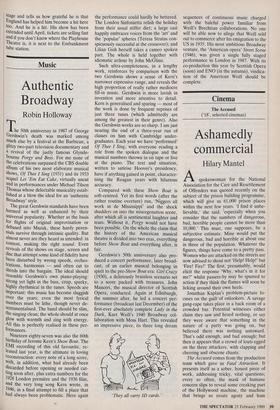Cinema
The Accused
(`18', selected cinemas)
Ashamedly commercial
Hilary Mantel
Aspokeswoman for the National Association for the Care and Resettlement of Offenders was quoted recently on the subject of the prison building programme, which will give us 61,000 prison places within the next few years. 'I find it unbe- lievable,' she said, 'especially when you consider that the numbers of dangerous, bad, horrible people cannot be more than 10,000.' This must, one supposes, be a subjective estimate. Mine would put the dangerous, bad and horrible at about one in three of the population. Whatever the figures, things have come to a pretty pass. Women who are attacked on the streets are now advised to shout not 'Help! Help!' but `Fire! Fire!' The first, presumably, would elicit the response 'Why, what's in it for me?' whilst passers-by may be spurred to action if they think the flames will soon be licking around their own heels. Jonathan Kaplan's problem-picture fo- cuses on the guilt of onlookers. A savage gang-rape takes place in a back room of a crowded bar. Potential witnesses either claim they saw and heard nothing, or say they were aware that something in the nature of a party was going on, but believed there was nothing untoward. That's odd enough, and bad enough; but then it appears that a crowd of louts egged on the three attackers, with clapping and cheering and obscene chants. The Accused comes from the production team which gave us Fatal Attraction. It presents itself as a sober, honest piece of work, addressing tricky, vital questions; every so often, the mask of humane concern slips to reveal some creaking part of the Hollywood machine, the machine that brings us ersatz agony and ham forensics and marketable heartbreak.
Sarah Tobias — cleverly and perceptive- ly played by Jodie Foster — has a quarrel with her boyfriend. She has a little drink, has a little smoke, and goes out to a bar wearing not very much. She is, in her own words, a low-class bimbo'. We first see her running from the bar after the attack has taken place; only at the end do we see what actually happened, so that for most of the film we have to suspend judgment. But just to look at Sarah, just to hear her speak, tells us what the court will think; it will think that she 'asked for it'.
This is the viewpoint of the Deputy District Attorney (Kelly McGillis). Feeling that Sarah will make a poor witness, she plea-bargains, and the attackers go to gaol for 'reckless endangerment'. The victim hears about this on television, and is understandably furious that her ordeal should not be given its proper name. The prosecutor, too, begins to feel that justice is not being served and decides — against the advice of her superiors — to take the matter back to court and charge the attackers' cronies with 'criminal solicita- tion'.
Kelly McGillis can make little of her underwritten role; economy is commend- able, but a woman in all her complexity cannot be represented by a pair of outsize shoulder-pads. The legal issues are foggy and ill-explained, and the film indulges in some facile images and suggestions, cutting at one point from the rape on the pinball table, with its circle of slobbering voyeurs, to the crowd watching a boxing match on the bar television set. The comparison is not well drawn. If the rape victim had a weigh-in and a referee and a chance of a knock-out, few would resort to law.
But almost in spite of itself, the film has its subtleties; it invites us to think, not only about guilt and complicity, but about the skewed perceptions of the rapist and the powerless rage and self-destructive frenzy the crime arouses in its victim. The final scenes, where we are shown the attack taking place, are more ugly and graphic than you expect — unless advance public- ity has prepared you. And that, of course, is the problem, though a problem for moralists, not for the box-office; the aforementioned dangerous, bad and horri- ble, waving their grubby and ill-gotten banknotes and failing to form an orderly queue, will jostle to see it for the sake of this now notorious scene, and what the director may think of as cinematic social work they will view as just good dirty fun. Whether the scene is necessary or justified is a matter of opinion, and mine diffidently proffered — is that it is used to make memorable an otherwise forgettable undertaking, and beef up a feeble and ailing drama; yet you cannot convict the film of cynicism. It is difficult to decide whether its sincerity is compromised by its commercialism, or its commercialism by its sincerity.

















































 Previous page
Previous page